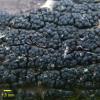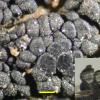
02-12-2012 17:42
Alain BRISSARDBonsoir à tousDemande de confirmation ou d'infirm

01-12-2012 18:01
 Nicolas VAN VOOREN
Nicolas VAN VOOREN
Bonjour.On m'a confié la détermination d'un Elap

02-12-2012 16:01
Esquivel-Rios EduardoHi AllThese small ascocarps were found in living l

02-12-2012 01:45
Esquivel-Rios EduardoHi All.This small wood escutellinia was found dead

26-09-2012 20:25
Dear friends: Have you some idea about this stran

27-11-2012 19:35
Hi to all:My friend F.J. Balda have sent to me fro

19-11-2012 16:44
Bonjour à tous.Lac des Rouges Truites, Jura, 2.10

28-11-2012 01:49
 Javier Retamino Hernandez
Javier Retamino Hernandez
Hi to allI think this new fungus for me is Coryne

26-11-2012 17:39
Dear friendsWe have collected these small (up to 0
Cucurbitaria elongata ??
Alain BRISSARD,
02-12-2012 17:42
Demande de confirmation ou d'infirmation
Des groupes assez denses de pseudothèces érompants d'environ 3/4 de mm chacun ont été observés sur rameaux morts de Robinier avec simultanément Nectria cinnabarina.
La coupe effectuée au niveau des pseudothèces me donne l'impression de l'existence d'un stroma basal. La forme et la taille des spores muriformes est tout à fait conforme avec les données bibliographiques. J'en ai conclu qu'il s'agissait de Cucurbitaria elongata plutot que de Cucurbitaria obducens qui pouvait être aussi soupçonné.Pas d'anamorphe observé.
Merci de vos avis
Alain GARDIENNET,
02-12-2012 18:37
Re : Cucurbitaria elongata ??
Salut Alain,
ça faisait un bail...
Je suis d'accord avec toi, ça devrait être elongata. as-tu observé un subiculum à la base ? J'ai des récoltes analogues, toutes sur ce substra,t que j'ai nommées aussi elongata.
Alain
Björn Wergen,
02-12-2012 20:08

Re : Cucurbitaria elongata ??
Bonsoir Alain,
je suis aussi d'accord par le C. elongata, une espèce characteristique sur branches morte de Robinia. Aujourd'hui j'ai trouvé Cucurbitaria obducens sur Crataegus.
Amicalement,
björn
je suis aussi d'accord par le C. elongata, une espèce characteristique sur branches morte de Robinia. Aujourd'hui j'ai trouvé Cucurbitaria obducens sur Crataegus.
Amicalement,
björn
Alain BRISSARD,
02-12-2012 22:48
Re : Cucurbitaria elongata ??
Cordialement merci à vous deux de me conforter dans ma démarche.
J'en profite pour vous remercier doublement car grace à ascofrance et vos dépots dans la banque de données j'ai pu déterminer aussi il y a 10 jours de cela Nectria decora qui se trouvait sur rameaux morts de Robinier parasitant Massaria anomia.
Encore merci et à plus
Alain
J'en profite pour vous remercier doublement car grace à ascofrance et vos dépots dans la banque de données j'ai pu déterminer aussi il y a 10 jours de cela Nectria decora qui se trouvait sur rameaux morts de Robinier parasitant Massaria anomia.
Encore merci et à plus
Alain
Stoykov Dimitar,
03-12-2012 10:23

Re : Cucurbitaria elongata ??
Excellent, Alain! Espece est Cucurbitaria elongata, sur tiges secches de Robinia pseudoacacia (Bulgaria). Check a poste!
Alain BRISSARD,
03-12-2012 16:53
Re : Cucurbitaria elongata ??
Merci également à toi Dimitar pour ta réponse. J'ai bien reçu en directe ta documentation
Cordialement
Alain
Cordialement
Alain



